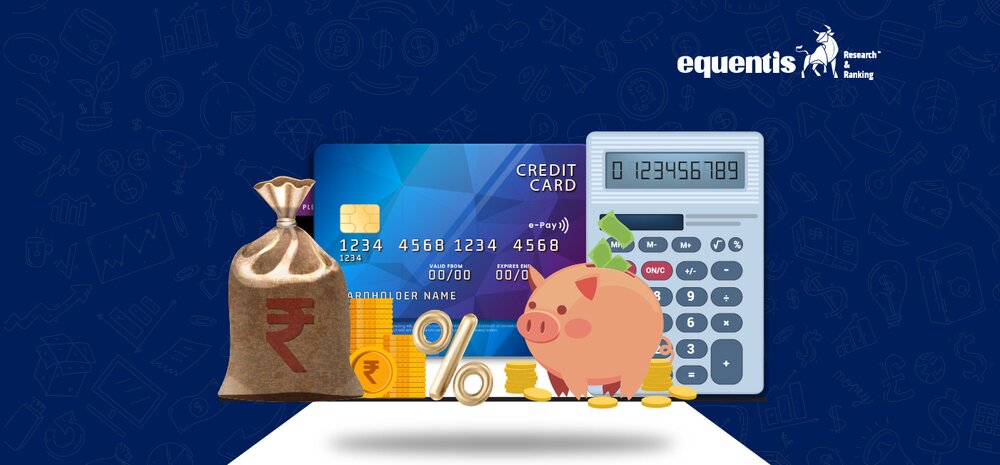Introduction:
Credit cards provide financial flexibility, allowing users to make purchases without immediate cash payments. However, if not managed wisely, they can lead to mounting debt due to interest charges. Understanding how credit card interest works is essential for avoiding unnecessary costs and staying financially healthy.
Interest charges on credit cards accumulate based on several factors, including the annual percentage rate (APR), daily periodic rate, and average daily balance. By learning how these components work, you can take proactive steps to reduce interest costs and make more informed financial decisions. This guide will break down the key aspects of credit card interest and provide strategies to manage it effectively.
Understanding Credit Card Interest Rates
A credit card’s interest rate, commonly expressed as the Annual Percentage Rate (APR), determines the cost of borrowing when you don’t pay your full balance by the due date. This charge applies to any unpaid amount and increases your overall debt. The interest rate on a credit card depends on multiple factors, including your credit score, the card type, and market trends. Since higher rates can accumulate significant debt over time, it’s crucial to be informed about how they work.
Credit card issuers impose finance charges in various situations, and these rates can differ between providers. As a cardholder, being aware of your card’s applicable interest rates is essential. Whether you are a frequent credit card user or just getting started, understanding these charges can help you manage your finances wisely.
Understanding Credit Card Interest Calculation
When reviewing your credit card statement, you’ll notice the interest rate is expressed as the Annual Percentage Rate (APR). This rate represents the cost of borrowing over a year rather than on a monthly basis. The interest on outstanding balances is determined using the following formula:
(No. of days counted from the date of transaction x Outstanding Amount x Interest rate per month x 12 months)/365
This calculation helps determine the exact interest amount accrued based on the time elapsed since the transaction date.
Key Elements in Credit Card Interest Calculation
Before jumping into the calculations, it’s important to understand the components that determine how much interest you pay:
1. Annual Percentage Rate (APR): APR represents the annual interest rate applied to your balance. Different types of transactions, such as purchases, balance transfers, and cash advances, may have separate APRs.
2. Daily Periodic Rate (DPR): This is the rate applied daily to your balance. It is derived by dividing the APR by 365 (or 366 during leap years).
3. Average Daily Balance (ADB): Most credit card issuers calculate interest based on ADB. This is determined by summing up your daily balances throughout the billing cycle and dividing by the number of days in that period.
4. Grace Period: Many credit cards offer a grace period of 20–25 days where no interest is charged on new purchases if the full balance is paid before the due date.
How Does Credit Card Interest Work?
Many credit card users are unaware of how interest is applied to their transactions. Let’s go through an example to understand when and how interest is charged.
Example Scenario:
Meet Mr. R, a credit cardholder. His recent credit card activity is as follows:
- Transaction Date: March 5, 2023
- Transaction Amount: ₹15,000
- Statement Date: March 10, 2023
- Minimum Amount Due (5%): ₹750
- Total Amount Due: ₹15,000
- Payment Due Date: March 28, 2023
- Annual Interest Rate: 40%
Now, let’s analyse different repayment situations.
Case 1: Full Payment by the Due Date
If Mr. R pays the full amount of ₹15,000 on or before March 28, no interest will be charged.
Case 2: Partial Payment Before the Due Date
Suppose he pays only ₹7,500 on March 20 while making no further purchases. The interest calculation will be:
- Interest on the full amount (₹15,000) from March 5 to March 20
- Formula: (16 days × ₹15,000 × 40%) ÷ 365
- Interest Charged: ₹263
- Interest on the remaining ₹7,500 from March 21 to April 10 (next statement date)
- Formula: (21 days × ₹7,500 × 40%) ÷ 365
- Interest Charged: ₹172
Total Interest Payable: ₹263 + ₹172 = ₹435
Case 3: Partial Payment After the Due Date
If Mr. R delays his payment and pays ₹7,500 on March 30, interest and late charges will be applied.
- Interest on ₹15,000 from March 5 to March 30
- Formula: (26 days × ₹15,000 × 40%) ÷ 365
- Interest Charged: ₹428
- Interest on the remaining ₹7,500 from March 31 to April 10
- Formula: (11 days × ₹7,500 × 40%) ÷ 365
- Interest Charged: ₹90
Total Interest Payable: ₹428 + ₹90 = ₹518
Case 4: Cash Withdrawal from an ATM
If Mr. R withdraws ₹8,000 in cash from an ATM on March 5 and repays it on March 9, he will be charged interest and a cash withdrawal fee.
- Interest on ₹8,000 from March 5 to March 9 (5 days)
- Formula: (5 days × ₹8,000 × 40%) ÷ 365
- Interest Charged: ₹44
Since interest on cash withdrawals begins immediately, even a few days’ delay leads to additional charges.
How Compounding Interest Affects Your Credit Card Debt
Understanding how credit card interest is calculated is key to managing your finances effectively. Unlike simple interest, credit card interest compounds daily. This means that every day, interest is applied to your existing balance, and the next day, you’re charged interest on that new amount. Over time, this cycle can significantly increase your debt, especially if you only make minimum payments or carry a balance from month to month.
Example of Compounding Interest in Action
Let’s break it down with a scenario:
Initial Balance: ₹50,000
Annual Percentage Rate (APR): 36% (or 3% per month)
Minimum Payment: ₹2,500 per month
If you stick to just the minimum payment of ₹2,500 each month, it would take you around 32 months to clear the debt. However, due to the daily compounding effect, you’d end up paying a staggering ₹29,400 in interest alone. This happens because every month, new interest is added to your balance, and the following month, interest is charged on that growing amount.
Smart Ways to Reduce Credit Card Interest Costs
Understanding how credit card interest works is the first step toward managing your debt efficiently. Now, let’s look at effective strategies to minimise interest charges and pay off your balance faster.
1. Pay More Than the Minimum: Instead of just covering the minimum amount each month, aim to pay a higher portion of your balance. This reduces the principal amount on which interest is calculated, helping you clear your debt sooner.
2. Make Multiple Payments: Rather than waiting until the due date, consider making smaller payments throughout the month. This approach lowers your average daily balance, ultimately reducing the total interest accrued.
3. Tackle High-Interest Debts First: If you have several credit cards, prioritise repaying the one with the highest interest rate while maintaining minimum payments on the others. This strategy, known as the “avalanche method,” helps you save on interest in the long run.
4. Utilise Balance Transfer Offers: Look for credit cards that offer low or 0% introductory APR on balance transfers. Transferring your balance to such a card can temporarily stop interest accumulation, giving you a window to pay off your debt at a lower cost. However, watch out for transfer fees and the duration of the promotional period.
5. Negotiate a Lower Interest Rate: Reach out to your credit card provider and ask for a lower APR, especially if you have a strong repayment history. Many issuers are open to reducing interest rates for reliable customers.
6. Avoid Cash Advances: Cash advances often carry high interest rates and start accruing interest immediately. Unless absolutely necessary, steer clear of withdrawing cash using your credit card.
7. Pay in Full Whenever Possible: The best way to avoid interest charges entirely is to clear your balance each month. By doing so, you can use your credit card without worrying about accumulating debt.
Why Timely Payments Matter
Missing a credit card payment doesn’t just result in late fees—it can also increase your interest rate and negatively impact your credit score. Since payment history is a crucial factor in credit score calculations, ensuring on-time payments is essential.
To stay on track, consider setting up automatic payments or reminders. Many credit card issuers allow you to automate payments for the minimum due, a fixed amount, or the full balance. This helps you avoid late fees, penalty APRs, and damage to your credit score.
By implementing these strategies, you can take control of your credit card debt and minimise interest charges effectively.
In conclusion, understanding how credit card interest works is key to maintaining financial health. By making timely payments, reducing your outstanding balance, and utilising smart repayment strategies, you can avoid excessive interest charges. Regularly reviewing your credit card statement and adopting responsible financial habits will help you stay in control of your finances and save money over time.
Related Posts
Disclaimer Note: The securities quoted, if any, are for illustration only and are not recommendatory. This article is for education purposes only and shall not be considered as a recommendation or investment advice by Equentis – Research & Ranking. We will not be liable for any losses that may occur. Investments in the securities market are subject to market risks. Read all the related documents carefully before investing. Registration granted by SEBI, membership of BASL & the certification from NISM in no way guarantee the performance of the intermediary or provide any assurance of returns to investors.
FAQ
How can I avoid paying credit card interest?
To avoid interest charges, always pay your full statement balance before the due date. This prevents any carried-over balance from accruing interest.
Does interest accrue daily on a credit card?
Yes, most credit cards apply interest daily based on the daily periodic rate. This means the longer you carry a balance, the more interest you accumulate.
Can I negotiate my credit card interest rate?
es, you can contact your issuer and request a lower APR, especially if you have a good payment history. Banks may offer better rates to retain responsible customers.
How useful was this post?
Click on a star to rate it!
Average rating 0 / 5. Vote count: 0
No votes so far! Be the first to rate this post.
I’m Archana R. Chettiar, an experienced content creator with
an affinity for writing on personal finance and other financial content. I
love to write on equity investing, retirement, managing money, and more.
- Archana Chettiar





















